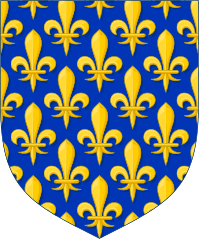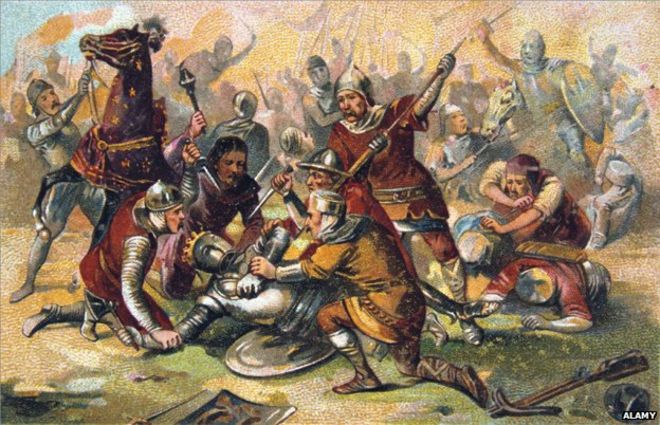Part II – The Prelude
"Seigneurs, dimanche est ce jour
Que notre Seigneur a consacré
Non pour oeuvrer ni combattre,
Mais pour se reposer, se distraire, s'amuser.
Ainsi, s'il plaît à Dieu, par si haut jour
Je n'aurai bataille, mais repos."
extract from “La chronique rimée”[1]
Sunday 26 August 1212, morning
The Royal army had started to cross the Somme at Voyennes in Vermandois, while the Imperial army approached in haste. Otto’s army made a forced march that morning, hoping to surprise the French who are running away, while crossing the Somme and destroy it. The Imperial vanguard attacked the French rear-guard commanded by the viscount Adam of Melun. Philip feel that a disaster could happened so, at the advice of Hospitaler brother Guerin who was his “Garde des Sceaux”, he give the order of battle. He cross back the Somme and plant the Oriflamme in the middle of the battlefield, guarded by Galon of Montigny. Duke of Burgundy took his knights and smash into the Imperial vanguard, releasing the viscount of Melun who was by now overwhelmed. They return victorious to the right flank of the army, cheered by the infantry who were in train to form the line.
The crossing back of the Somme and the forming of the battle line was done with an admirable precision, especially taking in consideration the fact that the bulk of the army was made by militias. Philip arrange his army in three battles.
In the center, the first line was made up by militias, enforced with some mercenaries and flanked by more experimented royal infantry, while the second line was made by heavy cavalry lead by the King in person and commanded by his loyal men: William des Barres, Bartholomew of Roye, Girard Scophe, William of Garland, Enguerrand III of Coucy and Gautier of Nemours. Right next the king was his
cousin, Pierre of Dreux, the jure uxoris Count of Flanders and Hainaut, with a small band of loyal knights.
The right wing was also dress in two lines, first one being formed by cavalry from Burgundy and Champagne under the overall command of Duke of Burgundy and seconded by brother Guerin, Gaucher III de Châtillon, Count of Saint-Pol, William I of Sancerre, Mathieu de Montmorency and Adam II Viscount of Melun, having in the second line the feudal infantry from their domains.
The left wing was similarly formed, under the command of Pierre of Courtenay, seconded by Simon of Montfort, William IV of Ponthieu and Robert II of Dreux. A small reserve was let to guard the bridge over the Somme under the command of Philip of Dreux, the Bishop of Beauvais. The terrain from the back and the left side of the army was marshy, while in the right side there was a small forest of willows and osiers, preventing ample flanking maneuvers.
On the other side of the battlefield, Otto was astonished seeing the French army dressing for the battle. He believe that they are running and expected a quick victory over the remaining troops. Anyway, confident in his superiority, he order his army to form up in battles.
In the center he put a line of heavy cavalry from Germany, formed by the troops of Duke Albert I of Saxony, Duke Frederick II of Lorraine, Duke Henry III of Limburg, Count William III of Jülich, Count Adolf VI of Berg and other minor nobles, backed by a strong infantry force of Brabancons and Saxon and he stand in the third line with his knights from Brunswick.
The right wing under the command of William Longsword seconded by Renaud of Damartin, Duke Henry I of Brabant and Count William I of Holland. It was dress in similar way, having cavalry in front and the infantry in the second line the bulk of the infantry was made by English and Brabancon mercenaries, reinforced by the feudal infantry.
The left wing was formed by the troops from Flanders and Hainaut under the command of Baldwin, reinforced by Philip II Courtenay, Margrave of Namur and Count Theobald I of Bar and Luxemburg. Same pattern, cavalry in front and infantry behind.
Otto knew that he had superior cavalry and wanted to crush the French using this weapon. His battle plan was brake the French centre using a charge of heavy cavalry followed by infantry assault and kill or captured the king. He place his famous standard on the centre of the battlefield mounted on a lavishly decorated chariot and guarded by a strong infantry troop. Present to the battlefield, Guillaume le Breton will relate in his “
Philipiades”, the impression made by the Imperial flag:
“On a chariot, he has a pole raised around which a dragon is curled which can be seen far away from all sides, its tail and wings bloated by the winds, showing its terrifying teeth and opening its enormous mouth. Above the dragon hovers Jupiter’s bird with golden wings while the whole of the surface of the chariot, resplendent with gold, rivals the sun and even boasts of shining with a brighter light”.
After a brief prayer, the French King make a speech to the troops, remembering that they fight for God and their King, against savage invaders, cursed and excommunicated by the Pope, who come for pillaging their lands and homes. The same Guillaume le Breton had kept for posterity a part of his words:
“Now, the Lord Himself is giving me what I wanted; now, beyond our merits and our hopes, divine favor is granting us more than all our wishes. Those we were previously trying to reach through long detours and the many turns of the roads, the Lord’s mercy has brought to us, so that He Himself could, through us, destroy His enemy in one blow. With our swords He will cut off the members of His enemies; He will turn us into cutting instruments; He will hit and we will be the hammer; He will lead the whole battle and we will be His ministers. I have no doubt that victory will be His, that He will triumph through us, that we will triumph through Him over His own enemies who bear Him so much hatred. [...] This is why, strengthened with the unbreakable power of hope, I am asking you to show yourselves to be the enemies of the enemies of the Church. May your fighting prevail, not for me but for you and the kingdom;”
A messenger was sent to Otto in order to ask him to respect the “
Paix de Dieu” and not give battle in that holy day of Sunday.
--------------------------------
Attached, there is the disposition of troops before the battle.
--------------------------------
Main Sources:
Wikipedia
http://deremilitari.org/2014/03/the-...bouvines-1214/
http://www.xenophongroup.com/montjoi...s.htm#campaign
"VIE DE PHILIPPE AUGUSTE Par RIGORD", by M. GUIZOT
“Richard I and the science of war in the middle age” by John Ghillinghan
http://xenophongroup.com/montjoie/oriflam.htm
http://www.earlyblazon.com/
[1] The original text is: "Signour, diémence est huï / Que nostre Sire a pris sour lui / C'on ne doit ouvrer ne combatre, / Mais reposer, déduire, esbatre. / Jà, se Dieu plest, par si haut jor / N'aurai bataille, mais séjor." - “La chronique rimée de Philippe Mousket” by Alain STRECK
http://bataille.bouvines.free.fr/textes/mousketvo.htm



